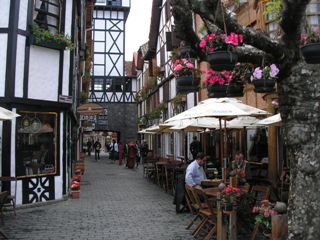 Near the bustling industrial city of Tieling in northeastern China, there is a brand new city some 6 miles down the road called Tieling New City. The place has everything going for it. Visitors will find excellent infrastructure, government offices, schools, shopping centers and apartment complexes. Land and labor costs are significantly lower than other areas of China. Tieling New City can now hold some 60,000 residents with projections of triple that number in the near future.The city even won a special recognition from the U.N. Human Settlements Program as an example of “providing a well-developed and modern living space.”
Near the bustling industrial city of Tieling in northeastern China, there is a brand new city some 6 miles down the road called Tieling New City. The place has everything going for it. Visitors will find excellent infrastructure, government offices, schools, shopping centers and apartment complexes. Land and labor costs are significantly lower than other areas of China. Tieling New City can now hold some 60,000 residents with projections of triple that number in the near future.The city even won a special recognition from the U.N. Human Settlements Program as an example of “providing a well-developed and modern living space.”
The only problem is that Tieling New City is virtually a ghost town with almost no inhabitants. It is a forced civilization.Tieling New City is a brainchild of socialist planners who still run the nation with social engineering and old-fashioned communist corruption. These planners spent millions of yuan cleaning up marshland that had been used to dump untreated sewage. The logic was build first and populate later. The project also served as an economic stimulus project. With the downturn in world economy, China is trying to artificially pump up its economy by creating construction jobs, burning up money by throwing up a number of ghost cities like Tieling New City all over the country.
In typical Communist Chinese fashion, these cities are riddled with bad loans and deals crafted by corrupt officials who often trample on the rights of farmers and villagers forced to evacuate the area. This inorganic top-down manner of creating a city out of thin air is a surefire formula for building a city without a civilization.
Tieling New City is truly a city without a soul. People simply don’t want to live there. There is no community life. There is no history or warmth. People feel more comfortable in crowded Tieling where they have links with friends, family and place.
Visitors cannot help but get an eerie feeling of being in a corpse-city when, at night, row after row of apartment buildings remain dark and nearly empty, save for a few residents and security guards. The industrial park is not much better. This vacant complex was built to be bustling with some 15,000 employees. Today, only two firms are there, one of which employs around 15 persons. Even with such dismal occupancy, there are still plans to double the park’s size. There is also a warehouse center on the outskirts of town that is virtually unused. Security guards seem to be the only real career opportunity in town with a future.
Despite the lack of enthusiasm for Tieling New City, the socialist planners were not easily discouraged. They came up with a set of socialist plans and schemes to move people in.
According to the Tieling government website, the industrial park created 5,000 jobs for rural workers in 2012. However, officials were soon disappointed to learn that most of the workers found places to live outside the new city. Officials then thought they found the solution when they moved many government offices from Tieling to Tieling New City. However, most government workers just commute from their old homes rather than move to the inhospitable city.
Officials went a step further by closing schools in the old city and forcing some 50,000 students to go to brand new schools in the new city. They hoped (against all hope) that parents would move closer to the schools. Alas, the parents are staying put. Despite the place’s outwardly pleasant appearance, they complain that the absence of community and services make the soulless city unlivable.
In face of such obstacles, socialist planners now believe the problem can be solved by building yet more facilities. According to The Wall Street Journal (8-9-13), the municipal government will be spending another $1.3 billion on new projects. Maybe, just maybe, officials reason, people will be attracted by an art gallery, a gymnasium, an indoor swimming pool, and another (empty) shopping center.

What central planners fail to realize is that cities must either be built organically or they will be empty shells. The most important components of the city are individuals, families and communities not warehouses, industrial parks and shopping centers.
As noted in my book, Return to Order, from the exuberant element of life together in society, there springs forth “unique systems of art, styles of life, socio-political institutions, and economic models that differ from the rigid and soulless central planning and one-size-fits-all solutions so prized by socialists and bureaucrats.”
Indeed, so many fail to consider this human element which is essential to sound economy. They think, like the Chinese socialist planners at Tieling New City, that economic health can be bought by simply injecting money into an area without any link to the inhabitants. Bring back family, morals and institutions to a city and it will acquire a soul. Until then, the world is doomed to continue building cities without souls.
